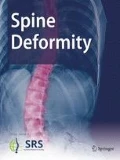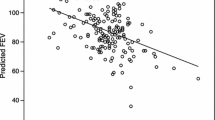Abstract
Study Design
Retrospective.
Objectives
We aimed to determine if heavier patients with adolescent idiopathic scoliosis (AIS) had more preserved thoracic kyphosis (TK), and as a result, more preserved pulmonary function.
Summary of Background Data
Some believe that childhood weight is predictive of adult sagittal plane parameters, with heavier children having greater TK as adults. Generally, thoracic scoliosis is coupled with loss of TK, which is associated with worsening pulmonary function.
Methods
A total of 142 patients with AIS and a structural main thoracic curve were analyzed. We excluded patients with structural proximal thoracic curves (Lenke 2 and 4). Standing preoperative radiographs, pulmonary function tests, and preoperative body mass indices (BMIs) were reviewed. The main thoracic Cobb angle, T2–T12 TK, percentage predicted forced vital capacity (FVC) and BMI were recorded. Spearman correlation was determined. Linear regression analysis used FVC as the primary outcome and BMI, TK, and Cobb angle as the independent variables. BMI categories were overweight/obese (BMI ≥25) and normal (BMI <25). Wilcoxon rank-sum tests were performed to detect a difference in TK and BMI between the 2 groups. The Cobb angles between the two groups were analyzed by t tests.
Results
Demonstrated correlations included BMI and FVC (0.37, p ≤.01), FVC and TK (0.26, p <.01), BMI and TK (0.23, p = .01), and FVC and Cobb angle (–0.23, p = .01). Linear regression revealed that Cobb angle (p ≤.01), TK (p <.01), and BMI (p <.01) remained statistically significant predictors of FVC. Wilcoxon rank-sum tests revealed a statistically significant difference between TK (p = .03) and FVC (p <.01) in the overweight/obese group and the normal group, with the overweight/obese group having greater values for both TK and FVC. The Cobb angles between the overweight/obese and normal group were not significantly different (p = .72).
Conclusions
Heavier AIS patients have greater values of TK and percentage predicted FVC.
Level of Evidence
Level III.
Similar content being viewed by others
References
Newton PO, Faro FD, Gollogly S, et al. Results of preoperative pulmonary function testing of adolescents with idiopathic scoliosis. J Bone Joint Surg Am 2005;87:1937–46.
Johnston CE, Richards BS, Sucato DJ, et al. Correlation of preoperative deformity magnitude and pulmonary function tests in adolescent idiopathic scoliosis. Spine 2011;36:1096–102.
Dreimann M, Hoffmann M, Kossow K, et al. Scoliosis and chest cage deformity measures predicting impairments in pulmonary function. Spine 2014;39:2024–33.
Smith AJ, O’Sullivan PB, Beales DJ, et al. Trajectories of childhood body mass index are associated with adolescent sagittal standing posture. Int J Pediatr Obes 2011;6:e97–106.
Li Y, Binkowski L, Grzywna A, et al. Is obesity in adolescent idiopathic scoliosis associated with larger curves and worse surgical outcomes? Spine (Phila Pa 1976) 2017;42:E156–62.
Xu L, Sun X, Zhu Z, et al. Body mass index as an indicator of pulmonary dysfunction in patients with adolescent idiopathic scoliosis. J Spinal Disord Tech 2015;28:226–31.
Jones RL, Nzekwu MM. The effects of body mass index on lung volumes. Chest 2006;130:827–33.
Author information
Authors and Affiliations
Corresponding author
Additional information
Author disclosures: RT (none), MU (none), JTA (paid speaker at an American Academy of Pediatrics CME course), KC (none), AS (none), RL (none).
Reviewed and approved by the Pediatric IRB at The Children’s Mercy Hospital & Clinics (IRB No. 16010073).
No funding was received for the purpose of this study.
Rights and permissions
About this article
Cite this article
Tung, R., Uvodich, M., Anderson, J.T. et al. Do Heavier Patients With Adolescent Idiopathic Scoliosis Have More Preserved Thoracic Kyphosis and Pulmonary Function?. Spine Deform 6, 704–706 (2018). https://doi.org/10.1016/j.jspd.2018.05.007
Received:
Revised:
Accepted:
Published:
Issue Date:
DOI: https://doi.org/10.1016/j.jspd.2018.05.007




